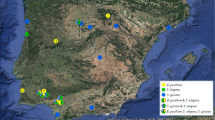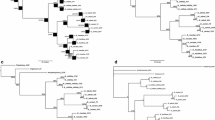Abstract
Relationships among three Japanese Laetiporus taxa (“L. sulphureus var. sulphureus” auct. jap., L. sulphureus var. miniatus, and L. versisporus) were assessed with phylogenetic analysis and incompatibility tests. Gene phylogenies inferred from the internal transcribed spacer region of nuclear ribosomal DNA, elongation factor 1α, and β-tubulin gene regions suggested that Japanese Laetiporus was divided into four groups: the yellow pore form of L. sulphureus var. miniatus, the white pore form of L. sulphureus var. miniatus, and two “L. sulphureus var. sulphureus”/ L. versisporus groups. A morphologically distinct species, Laetiporus versisporus, sharing a clade with “L. sulphureus var. sulphureus” auct. jap., was proved to be an anamorphic form of “L. sulphureus var. sulphureus” auct. jap. The “sulphureus/versisporus” isolates showed two divergent sequence types in each region. Some isolates had intraindividual polymorphism assigned to both sequence types. This finding suggests that speciation via hybridization is ongoing in the “sulphureus/versisporus” group. Single spore isolates from the “sulphureus/versisporus” group, white pore group, and yellow pore group were incompatible with each other. Our results provided strong support for the new recognition of three Laetiporus taxa in Japan.
Similar content being viewed by others
References
Banik MT, Burdsall HH (1999) Incompatibility between Laetiporus cincinnatus and L. sulphureus in culture. Mycotaxon 70:461–469
Banik MT, Burdsall HH (2000) Incompatibility groups among North American populations of Laetiporus sulphureus sensu lato. Mycologia 92:649–655
Banik MT, Burdsall HH, Volk TJ (1998) Identification of groups within Laetiporus sulphureus in the United States based on RFLP analysis of the nuclear ribosomal DNA. Folia Cryptogam Estonica 33:9–14
Burdsall HH, Banik MT (2001) The genus Laetiporus in North America. Harv Pap Bot 6:43–55
Felsenstein J (1985) Confidence limits on phylogenies: an approach using the bootstrap. Evolution 39:783–791
Garbelotto M, Ratcliff A, Bruns T, Cobb FW, Otrosina WJ (1996) Use of taxon-specific competitive-priming PCR to study host specificity, hybridization, and intergroup gene flow in intersterility groups of Heterobasidion annosum. Phytopathology 86:543–551
Gilbertson RL, Ryvarden L (1986) North American polypores. 1. Fungiflora, Oslo
Hughes K, Petersen R (2001) Apparent recombination or gene conversion in the ribosomal ITS region of a Flammulina (Fungi, Agaricales) hybrid. Mol Biol Evol 18:94–96
Imazeki R, Otani Y, Hongo T (1988) Fungi in Japan (in Japanese). Yama-kei, Tokyo
Imazeki R, Hongo T (1989) Colored illustrations of mushrooms of Japan, vol II (in Japanese). Hoikusha, Osaka
Jeanmougin F, Tompson JD, Gouy M, Higgins DG, Gibson TJ (1998) Multiple sequence alignment with Clustal X. Trends Biochem Sci 23:403–405
Kauserud H, Schumacher T (2003) Ribosomal DNA variation, recombination and inheritance in the basidiomycete Trichaptum abietinum: implication for reticulate evolution. Heredity 91:163–172
Newcombe G, Stirling B, Mcdonald S, Bradshaw HD Jr (2000) Melampora × columbiana, a natural hybrid of M. medusae and M. occidentalis. Mycol Res 104:261–274
Oda T, Tanaka C, Tsuda M (2004) Molecular phylogeny and biogeography of the widely distributed Amanita species, A. muscaria and A. pantherina. Mycol Res 108:885–896
Okabe I, Matsumoto N (2003) Phylogenetic relationship of Sclerotium rolfsii (teleomorph Athelia rolfsii) and S. delphinii based on ITS sequences. Mycol Res 107:164–168
Rogers SO, Hordenrieder O, Sieber TN (1999) Intraspecific comparisons of Laetiporus sulphureus isolates from broadleaf and coniferous trees in Europe. Mycol Res 103:1245–1251
Ryvarden L, Gilbertson RL (1993) European polypores. Fungiflora, Oslo
Stalper JA (1984) A revision of the genus Sporotrichum. Stud Mycol 24:1–105
Swofford DL (2001) PAUP*: phylogenetic analysis using parsimony (and other methods), version 4.0b8. Sinauer, Sunderland
White TJ, Bruns T, Lee S, Taylor J (1990) Amplification and direct sequencing of fungal ribosomal RNA genes for phylogenetics. In: Innis MA, Gelfand GH, Sninsky JJ, White TJ (eds) PCR protocols: a guide to methods and application. Academic Press, San Diego, pp 315–322
Author information
Authors and Affiliations
Corresponding author
About this article
Cite this article
Ota, Y., Hattori, T. Relationships among three Japanese Laetiporus taxa based on phylogenetic analysis and incompatibility tests. Mycoscience 49, 168–177 (2008). https://doi.org/10.1007/s10267-007-0403-3
Received:
Accepted:
Published:
Issue Date:
DOI: https://doi.org/10.1007/s10267-007-0403-3




